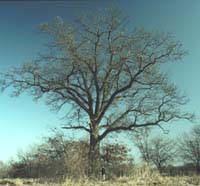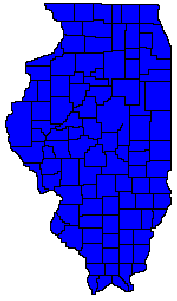 |
| Black
Oak (Quercus velutina)
Distribution
Map to Right |

Black oak is a large tree with a massive trunk of up to 3 1/2 feet in diameter. The crown is spreading, rounded or oblong, and often irregular. Black oak grows on a wide variety of upland sites from mesic to dry. In Illinois, black oak grows mostly in upland woods, but also occurs in flatwoods and savannas. It is one of the most common trees of the eastern deciduous forest, reaching a height of 70 to 80 feet.
Interesting
Facts
The species name 'velutina' is a reference to the underside of the leaves of black oak, which are covered with fine hairs. The yellowish-orange inner bark is bitter tasting. Black oaks typically are not as long lived as other oaks in the red oak group. They are also more susceptible to heartrot than some of the other oaks.
Identifying Features
BarkUses
The inner bark of black oak is yellow or orange, and is a distinctive feature of the tree. The outer bark is black and deeply furrowed and has a blocky appearance due to the presence of deep, horizontal grooves across the ridges.
Twigs
The twigs are reddish-brown with gray patches and are bitter tasting.
Buds
The buds are pointed, angled, hairy, and up to 3/4 inch long.
Leaves
The leaves are alternate and simple with 7 to 9 rather deeply incised (cut in from the edges) lobes which are tipped with bristles (stiff,, sharp hairs). The lobes are not as deeply incised when the tree is growing in the shade. Leaves are typically up to 10 inches long and up to 8 inches wide. They are dark green, smooth and shiny on the upper surface, and have fine hairs on the lower surface.
Flowers
Male and female flowers appear on the same tree, but separately, as the leaves start to unfold. Male flowers appear as drooping clusters (catkins) and females in clusters of 1 to 4. Acorns are either single or born in pairs, are oval, and up to 3/4 inch long.
Fruits
The nut has vertical lines that look like fine pin stripes running the length of the nut. Approximately 1/4 to 1/3 of the nut is enclosed by the cup, which is dull brown and hairy, with a small fringe at the bottom where the scales are not pressed up against the nut. The acorn is bitter, but a good food source for many songbirds, game birds, mice, raccoon, and deer. Acorns are produced once every two years.
Black oak wood is hard and coarse-grained. It is used in construction, for fence posts and fuel. The wood quality is lower than that of red oak, but the uses are similar for both species. Black oak wood often has defects, so the wood is not used as much as some of the other oaks.
Native Americans used black oak to treat a wide variety of ailments including indigestion, chills, fevers, respiratory problems, sore eyes, and more. It was also used as an antiseptic and an emetic (to induce vomiting).